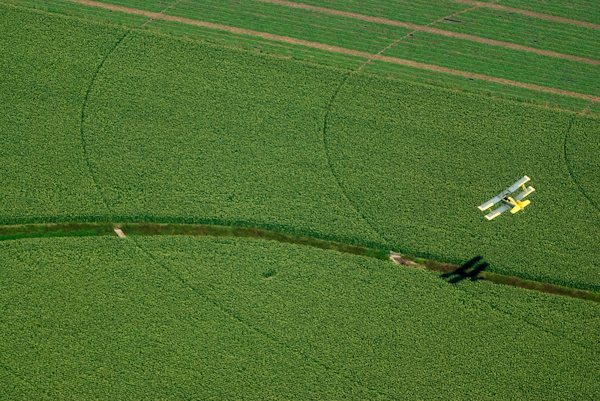SEJournal Online is the digital news magazine of the Society of Environmental Journalists. Learn more about SEJournal Online, including submission, subscription and advertising information.
 |
| A crop duster sprays agricultural land near the Choptank River in Caroline County, Md. Photo: Matt Rath/Chesapeake Bay Program via Flickr Creative Commons (CC BY-NC 2.0). |
Reporter’s Toolbox: Pesticide Data Can Ground Food and Farm Stories
By Joseph A. Davis
Journalists covering environmental health need to know about pesticide use — and its consequences. It’s a hard subject to cover, and solid data will be a boon to reality-based journalists. We have some suggestions.
Every year farmers use about one billion pounds of pesticides, herbicides, fungicides and rodenticides on U.S. crops. Those chemicals are designed to kill things, and, we hope, provide more benefit than harm to humans and ecosystems.
Pesticide residues can linger on
the foods we eat and run off into
the lakes and streams we drink from.
But residues can linger on the foods we eat and run off into the lakes and streams we drink from. From a health, policy and legal perspective this raises important and complex questions. Data helps ground any answers.
The U.S. Dept. of Agriculture is the mothership of ag data, largely through the National Agricultural Statistics Service, or NASS, and the Economic Research Service. These agencies took a budget drubbing during the Trump era but seem to have survived. Together, they offer a huge amount of data. But in this Toolbox we are focusing on pesticides.
Where the data come from
The foundational source of the NASS data comes from regular surveys of farmers. This is done in concert with grower organizations, agricultural universities, state ag agencies and other entities. We like to think this improves coverage.
It does help to remember that many in the ag community have a positive view of agricultural chemicals. USDA has a lot of other data, on the other hand, on the organic agriculture industry that you might want also to explore.
To start with, NASS runs a survey called the Agricultural Chemical Use Program (which also includes fertilizers). NASS also publishes its all-important Census of Agriculture on a five-year cycle, and sadly we don’t expect the next one out until 2024.
NASS compiles pesticide use surveys for individual crops more frequently, however, so recent years are available for impatient newshounds.
If you want to grab pesticide data right now, go to the list of latest releases. If you want a broader (and searchable) overview, go to their Quick Stats page.
How to use the data smartly
How you use all this data will depend on the nature of your project. We don’t assume you will only do deep-dive nerdy data journalism. Maybe you only want some good overview statistics. Maybe you want to drill down on the situation in your home county. Maybe you want to chronicle the changes in farm practices as the world (and climate) changes over the years.
If you are probing the connections between pesticide use and human or ecological health, you will probably want other data sources (for health and environmental data). So here are some suggestions for further information sources.
- U.S. Geological Survey: That’s right, the USGS loves data too and has an abiding interest in soils and water quality, so naturally it does track pesticide use. Even if the ultimate source of much of its data is the NASS, it may be smarter at interpreting it than your average environmental journalist. USGS estimates agricultural pesticide use annually, breaks it down by crop, breaks it down by state and presents it in map form.
- Environmental Working Group: This environmental advocacy group specializes in applying databases (and creating some of their own) to environmental issues. It publishes an annual Shopper’s Guide to Pesticides in Produce, which ranks the pesticide residues on many of the fruits and vegetables that consumers find in food markets. It uses data from the Food and Drug Administration, as well as from USDA.
- Beyond Pesticides: This advocacy group has lots of expertise about pesticides and works to put its knowledge into formats that are friendly and relevant for ordinary consumers. It often provides insights into human impacts that may be missing from NASS data.
- Food and Drug Administration: This federal agency measures and monitors the pesticide residues found on the food that people eat. It reports its findings annually and makes its data available online.
[Editor’s Note: For more on the topic, check out an Inside Story Q&A about covering the pesticide industry, a Feature on the food, ag and environment beat, a Backgrounder on the 2023 Farm Bill and TipSheets on pesticides on food and on farmers markets. Plus, visit our Topics on the Beat pages on agriculture and the food system.]
Joseph A. Davis is a freelance writer/editor in Washington, D.C. who has been writing about the environment since 1976. He writes SEJournal Online's TipSheet, Reporter's Toolbox and Issue Backgrounder, and curates SEJ's weekday news headlines service EJToday and @EJTodayNews. Davis also directs SEJ's Freedom of Information Project and writes the WatchDog opinion column.
* From the weekly news magazine SEJournal Online, Vol. 8, No. 25. Content from each new issue of SEJournal Online is available to the public via the SEJournal Online main page. Subscribe to the e-newsletter here. And see past issues of the SEJournal archived here.













 Advertisement
Advertisement 



